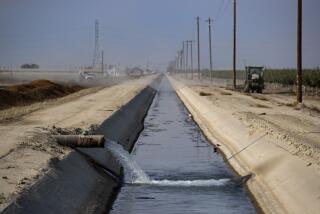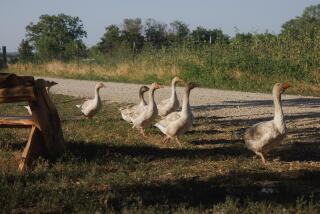Soil Erosion: the Silent Farm Crisis
- Share via
If we run out of water, pray for rain. If we run out of soil, pray for forgiveness.
-- Old Nebraska saying
Every gust of wind, every drop of rain strips precious topsoil from U.S. farmland. Three billion tons of soil are blown or washed away annually, rivaling the damage of the Great Dust Bowl of the 1930s. Farm program reforms are needed to solve this silent crisis of American agriculture in order to protect our agricultural productivity, water quality and fiscal health. Yet government farm subsidy programs have actually encouraged the crisis by making it profitable to grow commodities on highly erodible, less productive land.
I should know. I’m one of thousands of farmers forced to choose between making ends meet and conserving the soil. I have to compete against developers who can make a fast buck by bulldozing Nebraska’s fragile Sandhills into federally subsidized cropland. Conservation-minded farmers who refuse to till fragile lands are in effect penalized because their competitors, who do plow up delicate prairie, are rewarded with larger federal price supports.
Nearly half of all U.S. cropland is losing soil to erosion faster than it can be naturally regenerated. In Iowa, for example, slopes that once had three feet of topsoil now have just six inches. And, as erosion strips away the uppermost layers of soil, the land is robbed of its water and nutrient-holding capacity, which are essential for sustained plant growth. The exposed subsoils yield far fewer bushels of wheat, corn and other commodities.
The recent increase in agricultural productivity is deceptively short-term. Current high yields are being achieved at the risk of future declines in productivity due to erosion. For instance, wheat production in the fertile Palouse Region of eastern Washington state would be 20% higher if not for the enormous soil loss there. Nationwide, reduced yields cost farmers millions of dollars a year. If current erosion rates continue, agricultural productivity on fragile soils could decline by nearly a third over the next 50 years.
Soil erosion is also the single greatest untreated source of water pollution. Each year enough soil washes off farmland and into streams to cover an area the size of Indiana with a layer of soil an inch deep. Studies indicate that erosion causes at least $3 billion in damages annually to water quality, navigation, and fish and wildlife. Erosion costs everyone money.
Government farm policies and programs bear much of the responsibility for the increase in soil erosion. In the 1970s the U.S. Department of Agriculture encouraged farmers to plant crops on as much land as possible to increase agricultural exports. Since then total cultivated acres have increased by 15%. As a result of the Agriculture Department’s exhortations to plant “fence row to fence row,” many lands that had never been farmed were put to plow. Approximately 20% of the newly converted land was highly erodible.
The federal government is not doing enough about soil erosion. Existing programs provide some money to farmers to pay for erosion control, but these programs are not concentrated on the 12% of cropland responsible for half the problem. Agriculture Department research shows that a majority of farmers who own cropland with serious erosion are not enrolled in conservation programs. The only way to reduce erosion dramatically is to focus conservation on the most erodible land.
Fortunately, the farm bill that the President signed Monday would reverse past policies by encouraging rather than inhibiting soil conservation. The bill’s conservation reserve program would pay farmers to convert 40 million acres of the most erodible cropland to other less erosive uses such as grass or trees. This could cut total erosion by a third. The reserve program should also reduce commodity overproduction, stabilize crop prices and slash the cost of multibillion-dollar government farm programs.
The bill’s “sodbuster program” to penalize new cultivation of erosion-prone lands reverses the longstanding policy of subsidizing crops grown on any land, no matter how fragile. And, for the first time, farmers would be ineligible for any further subsidies if they did not use conservation techniques on their highly erodible cropland by 1995. Together these programs would actually save taxpayers money by reducing subsidies for erosion, runoff pollution and overproduction.
America’s fertile topsoil is one of our most precious--and irreplaceable--natural resources. Unless we farm its soil properly, our children and grandchildren won’t have enough healthy soil to produce their own food. The conservation reforms in the farm bill are a responsible first step toward protecting America’s priceless soil.
More to Read
Sign up for Essential California
The most important California stories and recommendations in your inbox every morning.
You may occasionally receive promotional content from the Los Angeles Times.













